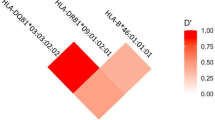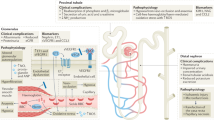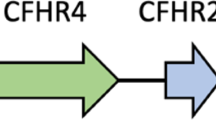Abstract
Hemolytic-uremic syndrome (HUS), mostly secondary to infectious diseases, is a common cause of acute kidney injury in children. It is characterized by progressive acute kidney failure due to severe thrombotic microangiopathy, associated with nonimmune, Coombs-negative hemolytic anemia and thrombocytopenia. HUS is caused mostly by Shiga toxin-producing E. Coli, and to a lesser extent by Streptococcus pneumonia. In Streptococcus pneumonia HUS (pHUS), bacterial neuraminidase A exposes masked O-glycan sugar residues on erythrocytes, known as the T antigen, triggering a complement cascade causing thrombotic microangiopathy. Atypical HUS (aHUS) is a life-threatening genetic form of the disease, whose molecular mechanism is only partly understood. Through genetic studies, we demonstrate a novel X-linked form of aHUS that is caused by a de-novo missense mutation in C1GALT1C1:c.266 C > T,p.(T89I), encoding a T-synthase chaperone essential for the proper formation and incorporation of the T antigen on erythrocytes. We demonstrate the presence of exposed T antigen on the surface of mutant erythrocytes, causing aHUS in a mechanism similar to that suggested in pHUS. Our findings suggest that both aHUS caused by mutated C1GALT1C1 and pHUS are mediated by the lectin-complement-pathway, not comprehensively studied in aHUS. We thus delineate a shared molecular basis of aHUS and pHUS, highlighting possible therapeutic opportunities.
This is a preview of subscription content, access via your institution
Access options
Subscribe to this journal
Receive 12 print issues and online access
$259.00 per year
only $21.58 per issue
Buy this article
- Purchase on Springer Link
- Instant access to full article PDF
Prices may be subject to local taxes which are calculated during checkout




Similar content being viewed by others
Data availability
Data support the findings of this study, including the WES raw data, are available from the corresponding author upon request (O.S.B) upon reasonable request.
References
Mele C, Remuzzi G, Noris M. Hemolytic uremic syndrome. Semin Immunopathol. 2014;36:399–420.
Nester CM, Barbour T, de Cordoba SR, Dragon-Durey MA, Fremeaux-Bacchi V, Goodship THJ, et al. Atypical aHUS: State of the art. Mol Immunol. 2015;67:31–42.
Yoshida Y, Kato H, Ikeda Y, Nangaku M. Pathogenesis of Atypical Hemolytic Uremic Syndrome. J Atheroscler Thromb. 2019;26:99–110.
Zuber J, Fakhouri F, Roumenina LT, Loirat C, Frémeaux-Bacchi V. Use of eculizumab for atypical haemolytic uraemic syndrome and C3 glomerulopathies. Nat Rev Nephrol. 2012;8:11. 2012;8:643–57
Angioi A, Fervenza FC, Sethi S, Zhang Y, Smith RJ, Murray D, et al. Diagnosis of complement alternative pathway disorders. Kidney Int. 2016;89:278–88.
Maga TK, Nishimura CJ, Weaver AE, Frees KL, Smith RJH. Mutations in alternative pathway complement proteins in American patients with atypical hemolytic uremic syndrome. Hum Mutat. 2010;31:E1445–60.
Sridharan M, Go RS, Willrich MAV. Atypical hemolytic uremic syndrome: Review of clinical presentation, diagnosis and management. J Immunol Methods. 2018;461:15–22.
Noris M, Remuzzi G. Atypical hemolytic-uremic syndrome. N. Engl J Med. 2009;361:1676–87.
Józsi M, Licht C, Strobel S, Zipfel SLH, Richter H, Heinen S, et al. Factor H autoantibodies in atypical hemolytic uremic syndrome correlate with CFHR1/CFHR3 deficiency. Blood 2008;111:1512–4.
Józsi M, Strobel S, Dahse HM, Liu WS, Hoyer PF, Oppermann M, et al. Anti–factor H autoantibodies block C-terminal recognition function of factor H in hemolytic uremic syndrome. Blood 2007;110:1516–8.
Lemaire M, Frémeaux-Bacchi V, Schaefer F, Choi M, Tang WH, Quintrec MLE, et al. Recessive mutations in DGKE cause atypical hemolytic-uremic syndrome. Nat Genet. 2013;45:5. 2013 Mar 31;45:531–6
Mele C, Lemaire M, Iatropoulos P, Piras R, Bresin E, Bettoni S, et al. Characterization of a new DGKE intronic mutation in genetically unsolved cases of familial atypical hemolytic uremic syndrome. Clin J Am Soc Nephrol. 2015;10:1011–9.
Delvaeye M, Noris M, Vriese A de, Esmon CT, Esmon NL, Ferrell G, et al. Thrombomodulin mutations in atypical hemolytic–uremic syndrome. N Engl J Med. 2009;361:345. Available from: https://pubmed.ncbi.nlm.nih.gov/19625716/.
Dahr W, Uhlenbruck G, Bird GWG. Cryptic A-like receptor sites in human erythrocyte glycoproteins: proposed nature of Tn-antigen. Vox Sang. 1974;27:29–42.
Berger EG. Tn-syndrome. Biochimica et Biophysica Acta (BBA) - Mol Basis Dis. 1999;1455:255–68.
Bolscher JGM, Brevoord J, Nazmi K, Ju T, Veerman ECI, Van Wijk JAE, et al. Solid-phase synthesis of a pentavalent GalNAc-containing glycopeptide (Tn antigen) representing the nephropathy-associated IgA hinge region. Carbohydr Res. 2010;345:1998–2003.
Friedenreich V. Investigations into the thomsen hemagglutination phenomena. Acta Pathologica Microbiologica Scandinavica. 1928;5:59–101.
Coats MT, Murphy T, Paton JC, Gray B, Briles DE. Exposure of Thomsen-Friedenreich antigen in Streptococcus pneumoniae infection is dependent on pneumococcal neuraminidase A. Micro Pathog. 2011;50:343–9.
McGraw ME, Lendon M, Stevens RF, Postlethwaite RJ, Taylor CM. Haemolytic uraemic syndrome and the Thomsen Friedenreich antigen. Pediatr Nephrol. 1989;3:135–9. Available from: https://pubmed.ncbi.nlm.nih.gov/2701864/.
Burin Des Roziers N, Chadebech P, Bodivit G, Guinchard E, Bruneel A, Dupré T, et al. Red blood cell Thomsen-Friedenreich antigen expression and galectin-3 plasma concentrations in Streptococcus pneumoniae-associated hemolytic uremic syndrome and hemolytic anemia. Transfusion. 2015;552:1563–71. https://pubmed.ncbi.nlm.nih.gov/25556575/.
Bird GWG. Anti-T in peanuts. Vox Sang. 1964;9:748–9.
Novogrodsky A, Lotan R, Ravid A, Sharon N. Peanut Agglutinin, a new mitogen that binds to galactosyl sites exposed after neuraminidase treatment. J Immunol. 1975;115:1243–8.
Gómez Delgado I, Corvillo F, Nozal P, Arjona E, Madrid Á, Melgosa M, et al. Complement genetic variants and FH desialylation in S. pneumoniae-Haemolytic Uraemic Syndrome. Front Immunol. 2021;12. Available from: https://pubmed.ncbi.nlm.nih.gov/33777036/.
Xia L, Ju T, Westmuckett A, An G, Ivanciu L, Mcdaniel JM, et al. Defective angiogenesis and fatal embryonic hemorrhage in mice lacking core 1-derived O-glycans. J Cell Biol. 2004;164:451–9.
Ju T, Cummings RD. Chaperone mutation in Tn syndrome. Nature. 2005;437:7063. 2005 Oct 26;437(7063):1252–1252.
Li H, Durbin R. Fast and accurate short read alignment with Burrows-Wheeler transform. Bioinformatics 2009;25:1754–60.
Picard Tools - By Broad Institute. Available from: http://broadinstitute.github.io/picard/.
Poplin R, Ruano-Rubio V, DePristo MA, Fennell TJ, Carneiro MO, Van der Auwera GA, et al. Scaling accurate genetic variant discovery to tens of thousands of samples. bioRxiv. bioRxiv; 2017;201178.
Chen X, Schulz-Trieglaff O, Shaw R, Barnes B, Schlesinger F, Källberg M, et al. Manta: Rapid detection of structural variants and indels for germline and cancer sequencing applications. Bioinformatics. 2016;32:1220–2. Available from: https://pubmed.ncbi.nlm.nih.gov/26647377/.
Karczewski KJ, Francioli LC, Tiao G, Cummings BB, Alföldi J, Wang Q, et al. The mutational constraint spectrum quantified from variation in 141,456 humans. Nature 2020;581:434–43.
L Phan, Y Jin, H Zhang, W Qiang, E Shekhtman, D Shao, et al. Allele Frequency Aggregator. Available from: https://www.ncbi.nlm.nih.gov/snp/docs/gsr/alfa/#citing-this-project.
Auton A, Abecasis GR, Altshuler DM, Durbin RM, Bentley DR, Chakravarti A, et al. A global reference for human genetic variation. Nature. Nature Publishing Group; 2015;526:68–74.
Landrum MJ, Lee JM, Benson M, Brown GR, Chao C, Chitipiralla S, et al. ClinVar: Improving access to variant interpretations and supporting evidence. Nucleic Acids Res. 2018;46:D1062–7.
Stenson PD, Mort M, Ball EV, Shaw K, Phillips AD, Cooper DN. The Human Gene Mutation Database: Building a comprehensive mutation repository for clinical and molecular genetics, diagnostic testing, and personalized genomic medicine. Hum Genet; 2014,133:1–9.
Lonsdale J, Thomas J, Salvatore M, Phillips R, Lo E, Shad S, et al. The Genotype-Tissue Expression (GTEx) project. 45, Nature Genetics. NIH Public Access; 2013;580–5.
Uhlen M, Fagerberg L, Hallstrom BM, Lindskog C, Oksvold P, Mardinoglu A, et al. Tissue-based map of the human proteome. Science (1979). 2015;347(6220):1260419–1260419.
Thul PJ, Akesson L, Wiking M, Mahdessian D, Geladaki A, Ait Blal H, et al. A subcellular map of the human proteome. Science (1979). 2017;356:eaal3321.
Pollard KS, Hubisz MJ, Rosenbloom KR, Siepel A. Detection of nonneutral substitution rates on mammalian phylogenies. Genome Res. 2010;20:110–21.
Rentzsch P, Schubach M, Shendure J, Kircher M. CADD-Splice—improving genome-wide variant effect prediction using deep learning-derived splice scores. Genome Med. 2021;13:31.
Jeanty P, Romero R, Hobbins JC. Fetal limb volume: a new parameter to assess fetal growth and nutrition. J Ultrasound Med. 1985;4:273–82. Available from: https://onlinelibrary.wiley.com/doi/full/10.7863/jum.1985.4.6.273.
Holle J, Habbig S, Gratopp A, Mauritsch A, Müller D, Thumfart J. Complement activation in children with Streptococcus pneumoniae associated hemolytic uremic syndrome. Pediatr Nephrol. 2021;36:1311–5.
Von Vigier RO, Seibel K, Bianchetti MG. Positive Coombs test in pneumococcus-associated hemolytic uremic syndrome. A review of the literature. Nephron 1999;82:183–4.
Scobell RR, Kaplan BS, Copelovitch L. New insights into the pathogenesis of Streptococcus pneumoniae–associated hemolytic uremic syndrome. Pediatr Nephrol. 2020;35:1585–91.
Brown EJ, Joiner KA, Frank MM. Interaction of desialated guinea pig erythrocytes with the classical and alternative pathways of guinea pig complement in vivo and in vitro. J Clin Invest. 1983;71:1710–9.
Çakar N, Ozcakar ZB, Ozaltin F, Koyun M, Celikel Acar B, Bahat E, et al. Atypical hemolytic uremic syndrome in children aged. Nephron 2018;139:211–8.
Sansbury FH, Cordell HJ, Bingham C, Bromilow G, Nicholls A, Powell R, et al. Factors determining penetrance in familial atypical haemolytic uraemic syndrome. J Med Genet. 2014;51:756–64.
Ricklin D, Reis ES, Mastellos DC, Gros P, Lambris JD. Complement component C3 - The “Swiss Army Knife” of innate immunity and host defense. Immunol Rev. 2016;274:33.
Fervenza FC, Sethi S. Circulating Complement Levels and C3 Glomerulopathy. Clin J Am Soc Nephrol. 2014;9:1829–31.
Tomaiuolo G. Biomechanical properties of red blood cells in health and disease towards microfluidics. Biomicrofluidics. 2014. Available from: https://pubmed.ncbi.nlm.nih.gov/25332724/.
Yedgar S, Koshkaryev A, Barshtein G. The red blood cell in vascular occlusion. Pathophysiol Haemost Thromb. 2002;32:263–8. https://pubmed.ncbi.nlm.nih.gov/13679654/.
Endo Y, Matsushita M, Fujita T. Role of ficolin in innate immunity and its molecular basis. Immunobiology 2007;212:371–9.
States DJ, Gish W. Combined use of sequence similarity and codon bias for coding region identification. J Comput Biol. 1994;1:39–50.
Matsushita M, Matsushita A, Endo Y, Nakata M, Kojima N, Mizuochi T, et al. Origin of the classical complement pathway: Lamprey orthologue of mammalian C1q acts as a lectin. Proc Natl Acad Sci USA. 2004;101:10127–31.
Funding
The study was funded by the Morris Kahn Family Foundation, the Israel Science Foundation (Grant no. 2034/18) awarded to OSB, and the National Knowledge Center for Rare/Orphan Diseases of the Israel Ministry of Science, Technology and Space, at Ben-Gurion University of the Negev and Soroka Medical Center, Beer-Sheva, Israel. The work of GS is supported in part by the Israel Ministry of Aliyah and Integration.
Author information
Authors and Affiliations
Contributions
The manuscript was written by NH with the assistance of RS, EK, YY and OSB. NH performed bioinformatics and WES analysis. NH and GS designed and performed experiments. Microscopy was performed with the assistance of IC. RS, MES, EK, GL, MG and AN contributed to clinical evaluation of the patient. The study was supervised by OSB.
Corresponding author
Ethics declarations
Competing interests
The authors declare no competing interests.
Ethics approval
The participants of this study provided written informed consent according to a protocol approved by the Soroka Medical Center institutional review board and by the Israel National Committee for Human Genetic Studies, in adherence with the Helsinki principles (ID5071G).
Additional information
Publisher’s note Springer Nature remains neutral with regard to jurisdictional claims in published maps and institutional affiliations.
Rights and permissions
Springer Nature or its licensor (e.g. a society or other partner) holds exclusive rights to this article under a publishing agreement with the author(s) or other rightsholder(s); author self-archiving of the accepted manuscript version of this article is solely governed by the terms of such publishing agreement and applicable law.
About this article
Cite this article
Hadar, N., Schreiber, R., Eskin-Schwartz, M. et al. X-linked C1GALT1C1 mutation causes atypical hemolytic uremic syndrome. Eur J Hum Genet 31, 1101–1107 (2023). https://doi.org/10.1038/s41431-022-01278-5
Received:
Revised:
Accepted:
Published:
Issue Date:
DOI: https://doi.org/10.1038/s41431-022-01278-5
This article is cited by
-
VARista: a free web platform for streamlined whole-genome variant analysis across T2T, hg38, and hg19
Human Genetics (2024)
-
Expanding what we know about rare genetic diseases
European Journal of Human Genetics (2023)
-
Exploration of glycosyltransferases mutation status in cervical cancer reveals PARP14 as a potential prognostic marker
Glycoconjugate Journal (2023)



